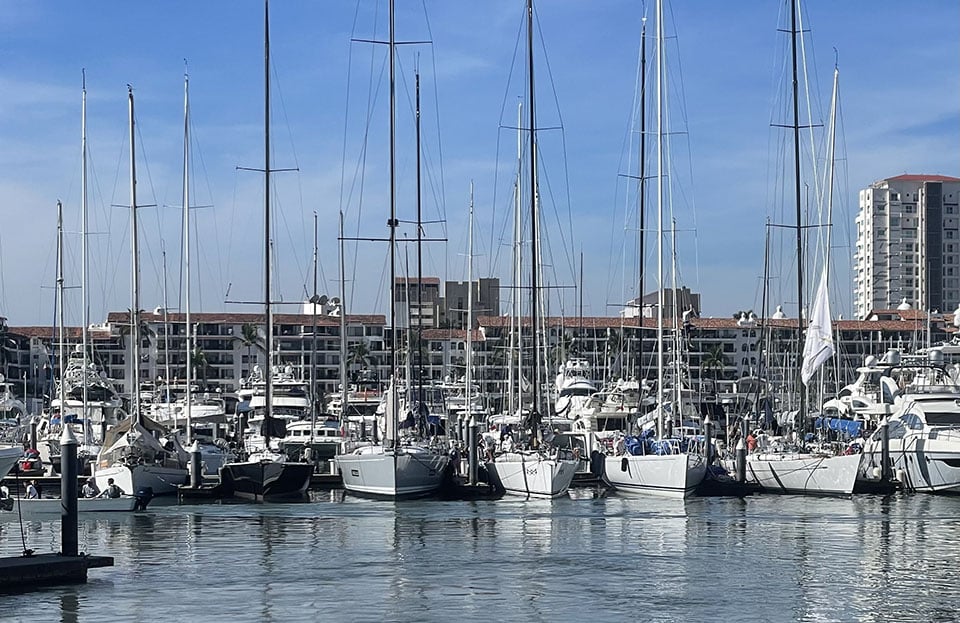
Kirk’s Race Report: MEXORC 2024 Sailing Regatta
Marina Vallarta hosts the racing fleet during the MEXORC Sailboat Regatta held every other March in even years. Above, Due West (in her shade canvas at left) hangs out among the big boys.
The local MEXORC race is preceded by a big International SDYC Puerto Vallarta Race, where sailboats race from San Diego nonstop to Puerto Vallarta. Typically a third to half of these race boats stay in PV for the MEXORC race on Banderas Bay. Most of the larger ocean racing boats that raced SD to PV (like Roy Disney’s Pyewacket) did not stay to race MEXORC, as they aren’t designed for buoy racing.
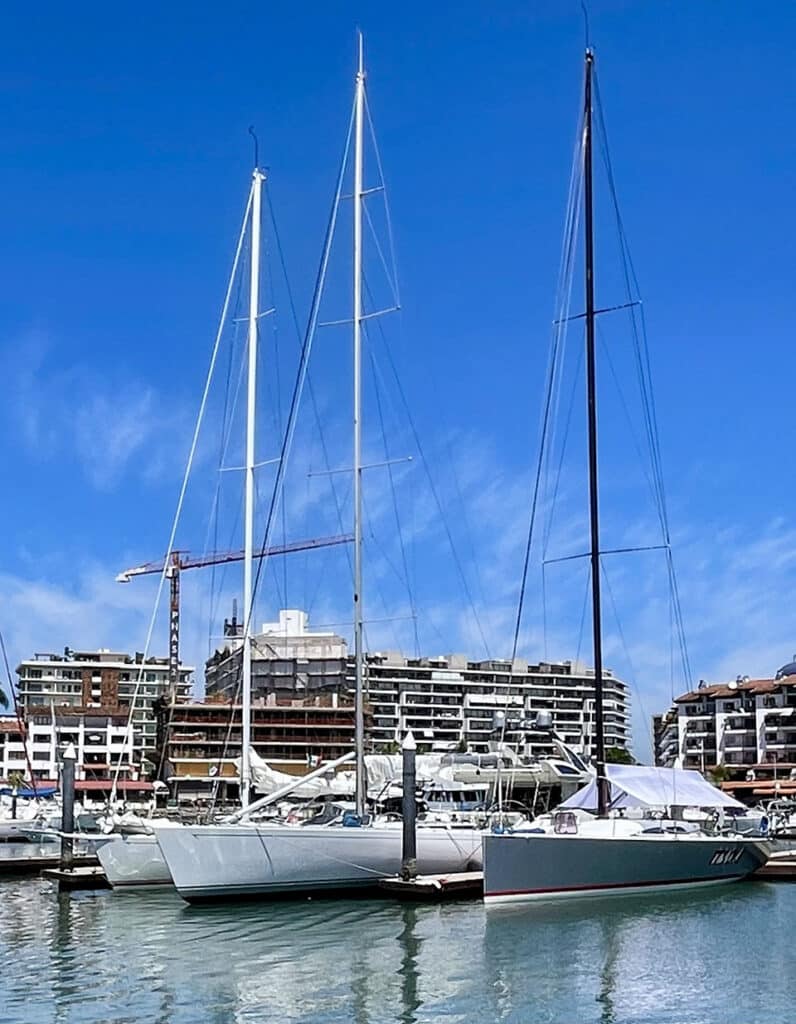

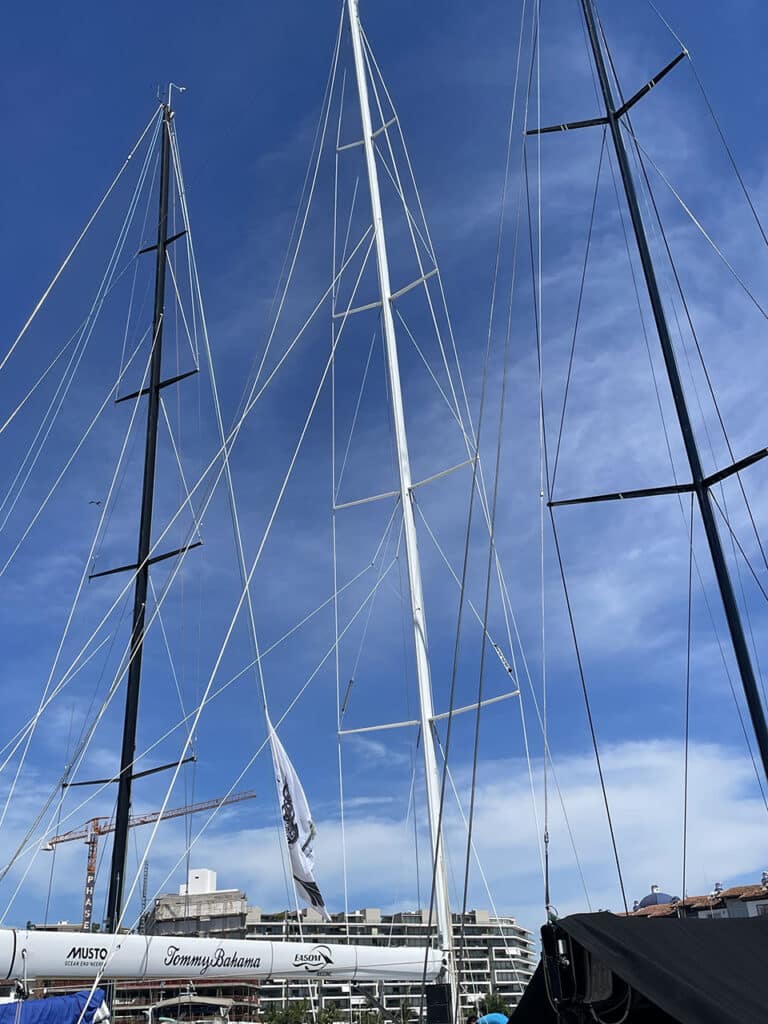
These racing sleds have very tall rigs (masts) with triple (3) or quad (4) spreaders (the horizontal bars across the mast that connect to the shrouds that hold the mast up). Due West has a 60′ mast and 2 spreaders, so you can imagine the height of these rigs! Many reaching yachts also fly “battle flags” with their team mascot or icon, these battle flags are on Pywacket, owned by Roy Disney (great-grand-nephew of Walt Disney.)
Mexican-owned boats from Acapulco and the local marinas in Banderas Bay rounded out the MEXORC fleet. This year’s MEXORC 2024 sailboat racing was held March 3-6 with a fleet of 20 boats sized 35-56’ divided into 3 racing classes.
Winds were typically breezy and even very lively at times. Afternoon winds on Banderas Bay in springtime are normally Northwest in the high teens to the mid and even high 20s.
The MEXORC race courses varied from day to day and included both short-leg buoy racing and longer-distance races. The different race courses provide opportunities for tactics and boat-handling skills. Generally, the shorter buoy races favor smaller boats and have several shorter legs with lots of mark roundings and sails going up and down. Distance races suit larger boats and have longer legs where changing wind shifts become a major tactical tool to get to the mark rounding first.

All the boats have satellite communications (satellite communication dome at left, Starlink at right) to provide up-to-the-minute weather info while racing.
When it’s very windy on the race course it adds extra excitement and a sense of urgency—particularly on shorter buoy courses. Things happen very fast on crowded courses at turning marks with jibs and spinnakers going up and down, mainsail booms swinging across, and getting splashed by wind-borne waves and spray. These conditions are part of the allure of sailboat racing and being in the warm air and tropical waters is uniquely fun for most racers.
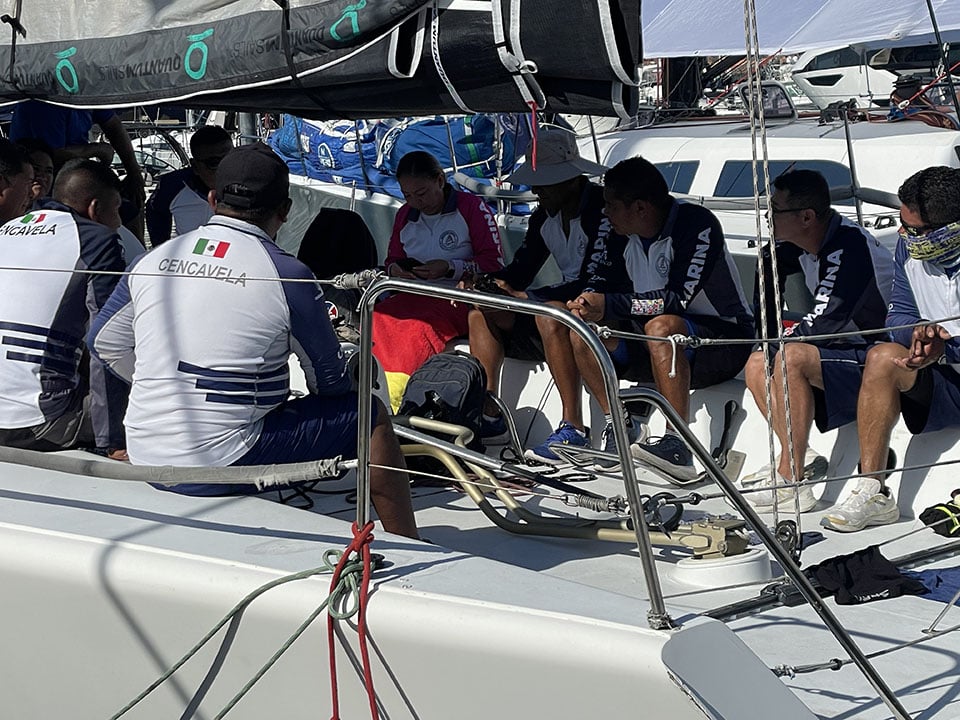

On a typical day racing crews arrive at their boats around 0900 after attending the skipper’s meeting where they’ve received course information and the daily weather briefings including anticipated winds.
Once at the boat, they mop up the dew, rig the spinnaker and jib sheets, and move sails and other gear they won’t need that day, up from below decks. The extra sails and gear get stored on the finger pier next to their slip (Due West at right, with Kirk’s bike aboard)—leaving us little room to maneuver! Most boats have a large inventory of sails to match different wind and wave conditions.

Boats blast off at 1030-ish heading out to check wind, waves, and current conditions to determine the favored end of the starting line and log running times up and downwind, and maybe even a spinnaker up and down drill. Races start at 1400.
After the race has started, any modifications to the race will be issued via radio. This year during one race the wind radically changed directions in the middle of the race, making the race unfair, so the race comity cancelled it. If you’re a racer and know about protest hearings, one boat protested the race committee over canceling the race. You can imagine how that turned out!
After the boats leave the marina to race, the docks are empty and look like a ghost town, except for the unnecessary sail bags and shoes left behind.

In late afternoon the boats return and soon it’s a dock party in full swing—with lots of chatting, beer drinking, and some race reenactment with hand motions.

Kirk loved talking to the crews, in the morning before the race and the afternoon post-race. Everyone was so friendly and it was fun to listen to the crews talk, and share what a cruiser’s life (like ours) is all about. Many of the crews got to know Kirk during the race week and gave him great race reports.
For example, one day’s race was a 76 mi long distance course out to nearby islands and back. Upwind sailing up and a glorious spinnaker run home in 20kt winds. Warm and beautiful. The reports were unanimous and everyone loved it, even if they didn’t win. There’s always tomorrow.

The cockpits on some of these race boats are as big as our entire boat! But nowhere to hang on when things get rough…
For us, we were so lucky not to have had to move Due West to another dock when they emptied almost all of our dock to make room for the race boats. Thank you, Pablo and Arturo!

As experienced big boat and ocean racers we love being around the crews and racing energy. There were a few Seattle crew here too, friends-of-friends, who were fun to meet. We also received several compliments on Due West, including smiling references to glimpses of Tosh and Tikka in the cockpit.
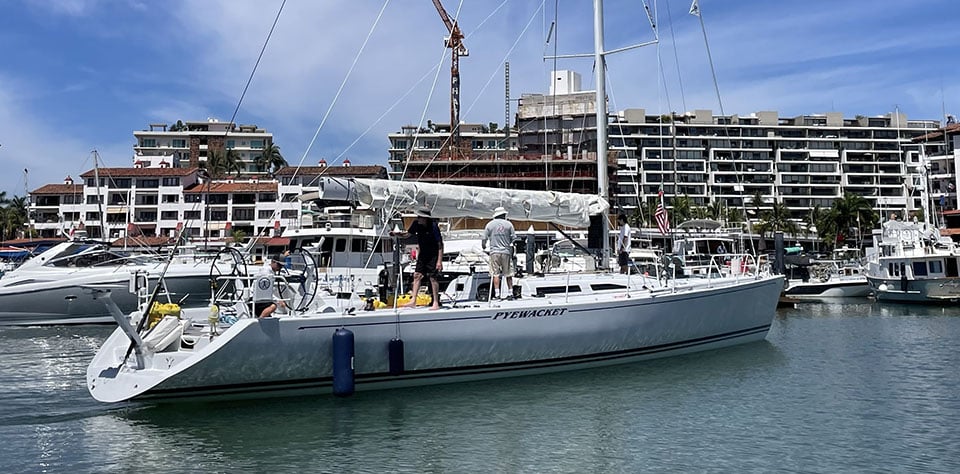
Pywacket heading out, back to SoCal.
Once the dust had settled after the racing was over, boats changed crews and put on their delivery sails for their return trips home—some south to Acapulco, most north to L.A. or the Bay Area. Within a few days, all the race boats had left, and displaced local boats moved back to our dock. And life was back to normal again.


Very nice reporting on the race scene. I used to tie up near PYEWACKET atd the now burned down CAL yACHT cLUB. Will be heading northwest soon to launch Forevergreen at Ancortes and proceed to a slip on Lopez where our neighbors are Steve and Robin Ward who remember you fondly. Big hugs. Rod Nash